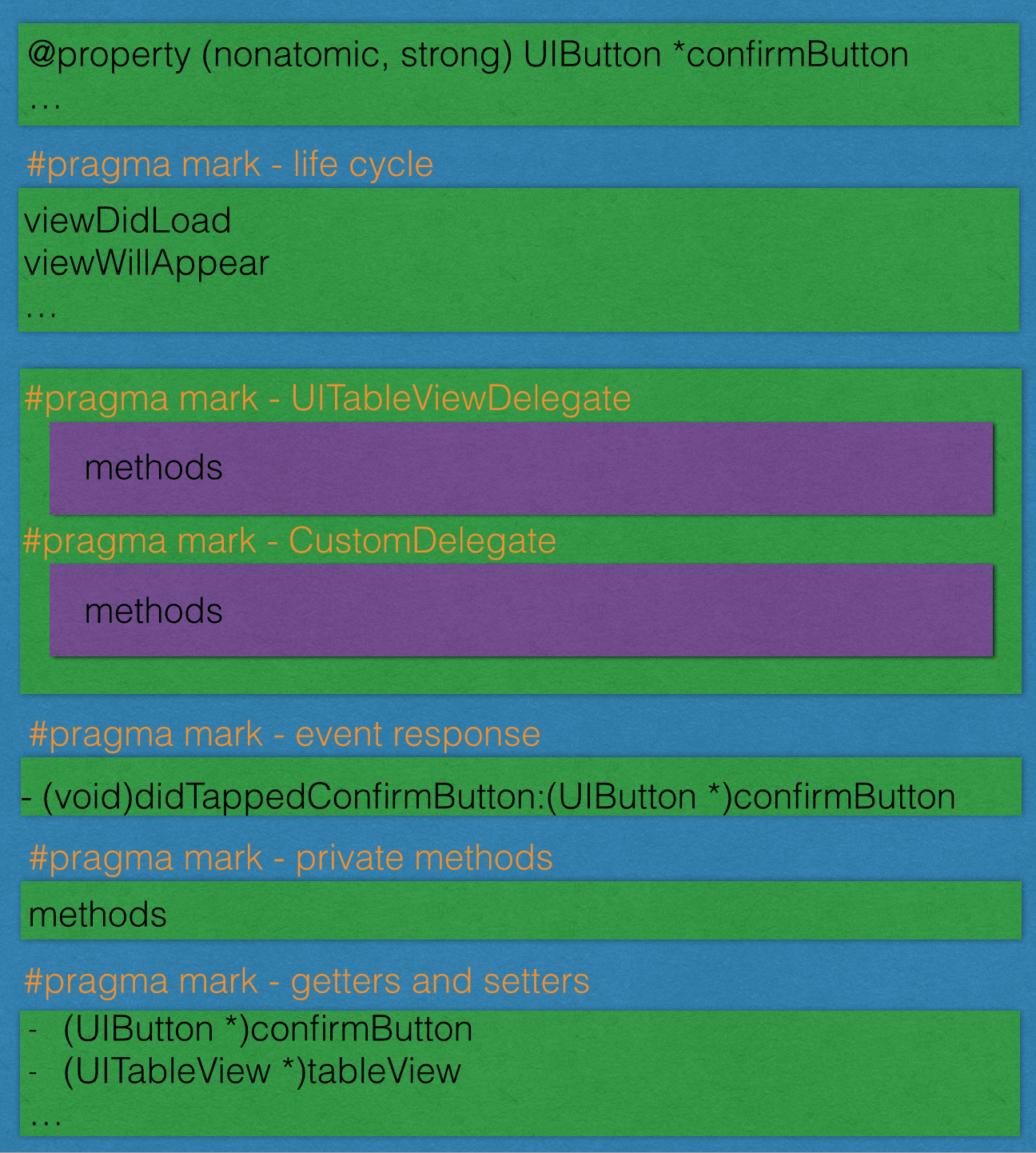不知不觉团队已经有了4个iOS开发,大家的代码风格完全不一样,所以每次改起别人的代码就头疼,理解起来不是那么顺畅,如鲠在喉。所以,就开了场分享会,把一些基本调用方法和代码风格统一了一下。
前言
主要参考了:
view层的组织和调用方案
更轻量的View Controllers
整洁的Table View代码
因为每个人的风格不一样,有些地方很难定义哪个好那个坏,但是同样的风格很重要,对团队有很大的好处。这些博客都详细介绍了这样做的原因,我这里就把他们的精髓吸取了,加了些自己的想法,就把格式直接定下来了。
ViewController代码结构

- 所有的属性都使用Lazy Init,并且放在最后。这样既美观,对于数组之类的属性也避免了崩溃
- viewDidLoad:addSubview,configData,这样会很美观
- viewWillAppear:布局,布局这个时候设好处很多,比如我们iPad版类似qq空间,一个VC容器里放两个,frame在WillAppear时在确定,这样复用到iPhone版本就不用修改什么。
设置Nav,TabBar是否隐藏,Status颜色。在WillDisAppear在设回原来的状态,这样就不会影响别人的VC。 - ViewDidAppear:添加Notification监听,在DidDisappear里remove掉。
- 每一个delegate都把对应的protocol名字带上,delegate方法不要到处乱写,写到一块区域里面去
- event response专门开一个代码区域,所有button、gestureRecognizer的响应事件都放在这个区域里面,不要到处乱放
- private/public methods,private methods尽量不要写,可能以后别的地方会用到,做一个模块或者category。
view的布局和写法
在一个VC或者View里,要么全用Masonry,要么全用frame。这个要统一,看起来很美观。
storyboard绝对不用,主要是纯代码结合xib。
有些人说storyboard是未来,是apple力推的。但是它不仅效率低,conflict还多。我们曾经分成很多很多小的storyboard减少conflict,但是最后做iPad版本时,整个布局变掉了,类似QQ空间的风格,它的复用性真的差,最后索性全部纯代码写,然后重做iOS版,几天就搞定了。所以只后就彻底抛弃了storyboard。
一些通用的逻辑或者页面是否使用继承来实现?
尽量不通过继承,这也是设计模式中最常说的多用组合少用继承。
很多情况可以使用category或者delegate来实现。
还有就是AOP,它需要一个拦截器,Mehtod Swizzling是个很好的手段。Aspects是个开源的库,利用Mehtod Swizzling实现拦截的功能。
这样很多功能可以统一处理,代码的侵入性很小。比如打点,自定义导航栏,导航栏回退按钮,cell的箭头的统一的设置等。
+ (void)load {
static dispatch_once_t onceToken;
dispatch_once(&onceToken, ^{
Class class = [self class];
// 如果 swizzling 的是类方法, 采用如下的方式:
// Class class = object_getClass((id)self);
// ...
// Method originalMethod = class_getClassMethod(class, originalSelector);
// Method swizzledMethod = class_getClassMethod(class, swizzledSelector);
SEL originalSelector = @selector(viewWillAppear:);
SEL swizzledSelector = @selector(swizzling_viewWillAppear:);
Method originalMethod = class_getInstanceMethod(class, originalSelector);
Method swizzledMethod = class_getInstanceMethod(class, swizzledSelector);
method_exchangeImplementations(originalMethod, swizzledMethod);
});
}
#pragma mark - Method Swizzling
- (void)swizzling_viewWillAppear:(BOOL)animated {
[self swizzling_viewWillAppear:animated];
if (self.navigationController.viewControllers.count > 1) {
UIButton *backButton = [UIButton buttonWithType:UIButtonTypeCustom];
backButton.frame = CGRectMake(0, 0, 44, 44);
[backButton setTitle:@"" forState:UIControlStateNormal];
[backButton setImage:[UIImage imageNamed:@"back_black_icon"] forState:UIControlStateNormal];
[backButton setImageEdgeInsets:UIEdgeInsetsMake(0, -22, 0, 0)];
[backButton addTarget:self action:@selector(backEvent) forControlEvents:UIControlEventTouchUpInside];
UIView *leftView = [[UIView alloc] initWithFrame:CGRectMake(0, 0, 44, 44)];
[leftView addSubview:backButton];
self.navigationItem.leftBarButtonItem = [[UIBarButtonItem alloc] initWithCustomView:leftView];
}
}
MVC,MVVM,胖Model,瘦Model
所有的这些选择,其实就是为了给ViewController减负。难点就是怎么去拆分。通俗点讲就是ViewController代码行数很少,拆分出来的部分能复用,并且逻辑清晰。
viewController的作用就是数据请求,处理数据,显示在View上。
数据请求
数据请求是指从服务端或者本地文件,数据库取数据,VC不需要知道从哪里取,只需要数据,我们的做法统一是:
ViewController.m
- (void)configData {
[CTPlanDataManager configPlanJsonDataWithPlanId:planId success:^(NSDictionary *dict) {
} failure:^(NSError *error) {
}];
}
- (void)viewDidLoad {
[super viewDidLoad];
[self configData];
}
CTPlanDataManager.m
- (void)configPlanJsonDataWithPlanId:(NSUInteger) planId
success:(RequestOSSSuccessDictBlock) success
failure:(RequestOSSFailureBlock) failure {
if ([self planJsonFileExistsWithPlanId:planId]) { //判断本地有没有
NSDictionary *dict = [self readPlanJsonFromFileWithPlanId:planId];
if (success) {
success(dict);
}
}
else {
[self downloadPlanJsonFileWithPlanId:planId progress:nil success:^(NSDictionary *dict) { //从阿里云上取
if (success) {
success(dict);
}
} failure:^(NSError *error) {
if (failure) {
failure(error);
}
}];
}
}
处理数据
处理数据的逻辑全部放在model里,通过model直接获取需要展现的数据。
model.h
@property (nonatomic, strong) NSArray<NSString *> *serviceArray; //从服务端获取的
@property (nonatomic, strong) NSArray< NSString *> *handleArray; //model处理过的
model.m
- (void)setServiceArray:(NSArray *) serviceArray {
_serviceArray = serviceArray;
NSMutableArray< NSString *> *handleArray = [[NSMutableArray alloc] init];
for(NSString *value in _serviceArray) {
//一些逻辑处理
handleValue = [value doSomething];
[handleArray addObject:handleValue];
}
_handleArray = handleArray;
}
数据显示
把处理后的数据显示在View上,这个比较容易,主要就是自定义View,只留出初始化方法和赋值方法。
主要需要注意的地方赋值的时候要分离model和view,可以用category来实现赋值函数。
@implementation CTHeaderView (ConfigureForInfor)
- (void)configureForInfor:(CTInfor *) myInfor
{
self.nameTitleLabel.text = myInfor.name;
NSString* date = [self.dateFormatter stringFromDate: myInfor.birthday];
self.dateLabel.text = date;
......
}
@end
UITableview,UICollectionView
这两个View是最常用的比较重的View。比较复杂的UI一般都用到他们。这个时候cell比较多,viewController比较臃肿,所以必须规范。
- dataSource,delegate,UICollectionViewLayout等必须分离出去写
- 在cell内部控制cell的状态。
//点击的反馈
- (instancetype)initWithStyle:(UITableViewCellStyle)style reuseIdentifier:(NSString *)reuseIdentifier {
.....
self.selectedBackgroundView = self.selectView;
}
//高亮状态的行为
- (void)setHighlighted:(BOOL)highlighted animated:(BOOL)animated
{
[super setHighlighted:highlighted animated:animated];
if (highlighted) {
......
} else {
......
}
}
- 控制多个Cell类型的写法风格
typedef NS_ENUM(NSUInteger, ProgressCellTag) {
ProgressDateCellTag = kMinTag,
ProgressBlankCellTag,
ProgressTrainNoticeCellTag,
ProgressTimeNoticeCellTag,
ProgressActionCellTag,
};
- (UITableViewCell *)tableView:(UITableView *)tableView cellForRowAtIndexPath:(NSIndexPath *)indexPath {
switch (self.dataSource[indexPath.row].integerValue) {
case ProgressActionCellTag:
return [self tableView:tableView actionCellForRowAtIndexPath:indexPath];
break;
case ProgressDateCellTag:
return [self tableView:tableView dateCellForRowAtIndexPath:indexPath];
break;
case ProgressTimeNoticeCellTag:
return [self tableView:tableView timeNoticeCellForRowAtIndexPath:indexPath];
break;
case ProgressTrainNoticeCellTag:
return [self tableView:tableView trainNoticeCellForRowAtIndexPath:indexPath];
break;
case ProgressBlankCellTag:
return [self tableView:tableView blankCellForRowAtIndexPath:indexPath];
break;
default:
break;
}
return nil;
}
#pragma mark - Cell Getter
- (UITableViewCell *)tableView:(UITableView *)tableView actionCellForRowAtIndexPath:(NSIndexPath *)indexPath {
//
}
- (UITableViewCell *)tableView:(UITableView *)tableView dateCellForRowAtIndexPath:(NSIndexPath *)indexPath {
//
}
- (UITableViewCell *)tableView:(UITableView *)tableView timeNoticeCellForRowAtIndexPath:(NSIndexPath *)indexPath {
//
}
- (UITableViewCell *)tableView:(UITableView *)tableView trainNoticeCellForRowAtIndexPath:(NSIndexPath *)indexPath {
//
}
- (UITableViewCell *)tableView:(UITableView *)tableView blankCellForRowAtIndexPath:(NSIndexPath *)indexPath {
//
}
总结
统一的风格和方式,使我们的逻辑更加清晰。尤其是改别人的代码时,定位问题非常快,只需要理解他的处理逻辑,基本上就是改自己的代码。